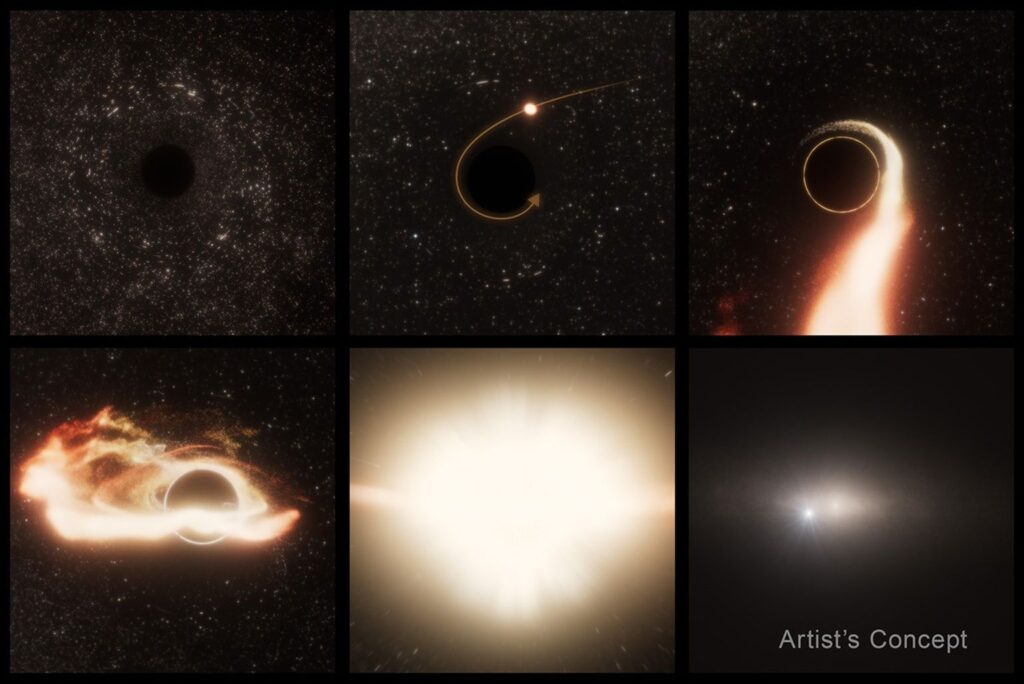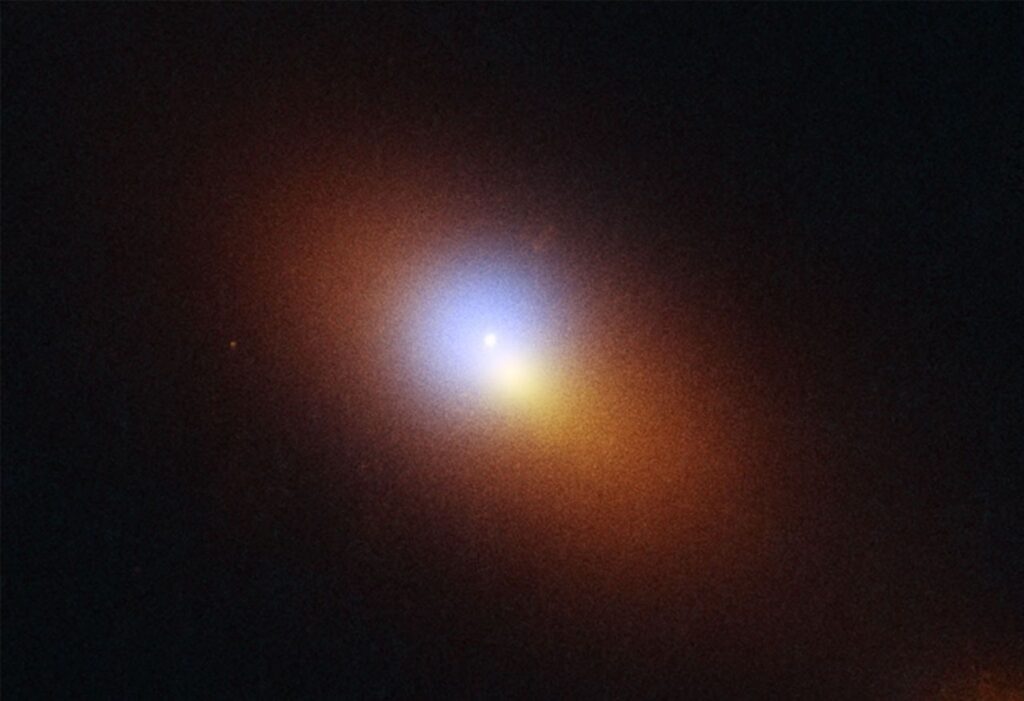Introduction
Imagine a supermassive black hole, millions of times the mass of our Sun, silently drifting through the cosmos-far from the heart of any galaxy. Now, picture this cosmic wanderer suddenly revealing itself in a spectacular burst of light as it tears apart an unsuspecting star. In early 2025, astronomers captured this exact event-an unprecedented cosmic drama that is rewriting what we know about black holes and the galaxies they inhabit.
Table of Contents
- What Is a Rogue Black Hole?
- The Hubble Discovery: AT2024tvd Explained
- What Is a Tidal Disruption Event (TDE)?
- How Do Rogue Black Holes Form?
- Why Is This Discovery So Important?
- The Science Behind the Observation
- What Happens When a Star Meets a Black Hole?
- The Future: Hunting for More Rogue Black Holes
- Key Takeaways for Astronomy Enthusiasts
- FAQs About Rogue Black Holes and TDEs
What Is a Rogue Black Hole?
Most supermassive black holes are found at the centers of galaxies, anchoring billions of stars with their immense gravity. But not all black holes stay put. A rogue black hole is one that has been ejected from its galactic core and now drifts through intergalactic space, unbound and nearly invisible-until it interacts with something, like a star.
These cosmic nomads are notoriously difficult to detect because, unless they are feeding on matter, they emit no light. Their presence is often only betrayed by their gravitational effects or, as in this case, by a dramatic cosmic event.
The Hubble Discovery: AT2024tvd Explained

This six-panel illustration of a tidal disruption event around a supermassive black hole shows the following: 1) A supermassive black hole is adrift inside a galaxy, its presence only detectable by gravitational lensing; 2) A wayward star gets swept up in the black hole’s intense gravitational pull; 3) The star is stretched or “spaghettified” by gravitational tidal effects; 4) The star’s remnants form a disk around the black hole; 5) There is a period of black hole accretion, pouring out radiation across the electromagnetic spectrum, from X-rays to radio wavelengths; and 6) The host galaxy, seen from afar, contains a bright flash of energy that is offset from the galaxy’s nucleus, where an even more massive black hole dwells.
In January 2025, NASA’s Hubble Space Telescope captured an extraordinary image: a brilliant flash of light from deep space, later identified as a tidal disruption event (TDE) named AT2024tvd. What made this event historic was its location-not at the center of a galaxy, but thousands of light-years from the galactic core. This was the first time astronomers had observed a TDE caused by a rogue supermassive black hole, opening a new window into the hidden population of wandering black holes in the universe.
“AT2024tvd marks the first offset disruption event identified through optical sky surveys, and it opens up the potential to uncover this elusive group of wandering black holes in future observations.”
- Yuhan Yao, University of California, Berkeley
What Is a Tidal Disruption Event (TDE)?

A Tidal Disruption Event occurs when a star passes too close to a black hole and is pulled apart by its immense gravitational forces. The star is stretched and compressed-spaghettified-by tidal forces, forming a stream of stellar material. Some of this material is captured into orbit around the black hole, creating a temporary accretion disk that emits intense electromagnetic radiation, visible across the universe.
Key Features of TDEs:
- Bright Flare: A sudden, powerful burst of light across multiple wavelengths.
- Accretion Disk: Material spirals into the black hole, heating up and glowing.
- Duration: The event can last from months to years as the black hole consumes the debris.
- Jets: In rare cases, relativistic jets are launched, emitting X-rays and radio waves.
TDEs are rare, with only about a hundred observed since the 1990s, and even fewer involving rogue black holes.
How Do Rogue Black Holes Form?
There are several ways a supermassive black hole can become a rogue wanderer:
- Galactic Mergers: When two galaxies collide, gravitational interactions can sling one of the central black holes out of the merged system.
- Gravitational Slingshot: Interactions with other massive objects can accelerate a black hole to escape velocity.
- Failed Mergers: Sometimes, during the chaotic dance of merging galaxies, a black hole doesn’t settle into the new core and is ejected.
Once ejected, the black hole drifts through space, invisible unless it interacts with other matter.
Why Is This Discovery So Important?
This is the first time astronomers have directly observed a TDE caused by a rogue supermassive black hole outside a galactic core. Here’s why this matters:
- New Population: It confirms the existence of a hidden population of wandering supermassive black holes.
- Galaxy Evolution: Understanding rogue black holes helps explain how galaxies grow, evolve, and sometimes lose their central black holes.
- Black Hole Detection: TDEs provide a unique method to detect otherwise invisible black holes.
- Astrophysical Laboratories: These events allow scientists to study extreme physics, including gravity, relativity, and the behavior of matter under intense forces.
The Science Behind the Observation
The event AT2024tvd was first spotted by the Zwicky Transient Facility, which scans the sky for sudden flashes of light. Follow-up observations with Hubble’s Wide Field Camera 3 confirmed the source: a supermassive black hole, about one million times the mass of the Sun, devouring a star in a galaxy 600 million light-years away.

What set this event apart was its offset location-about 2,600 light-years from the galaxy’s nucleus. This rules out the possibility that it was the central black hole and strongly suggests it is a rogue, wandering through the galaxy.
What Happens When a Star Meets a Black Hole?
When a star ventures too close to a black hole, the difference in gravitational pull between the star’s near and far sides becomes extreme. This tidal force stretches the star into a long, thin stream-a process known as spaghettification. About half of the star’s material is flung into space, while the rest forms a glowing disk around the black hole, emitting intense light and sometimes launching jets of high-energy particles.
This process is not only visually spectacular but also provides a rare opportunity to study black holes in action.
The Future: Hunting for More Rogue Black Holes
The discovery of AT2024tvd is just the beginning. With powerful telescopes like Hubble and new sky surveys coming online, astronomers expect to find many more rogue black holes by catching them in the act of devouring stars. Each new discovery will help answer fundamental questions:
- How common are rogue supermassive black holes?
- What role do they play in galaxy evolution?
- Can they form new galaxies or disrupt existing ones?
Key Takeaways for Astronomy Enthusiasts
- Rogue black holes are real and can be detected when they interact with stars.
- The AT2024tvd event is the first confirmed TDE caused by a rogue supermassive black hole outside a galactic core.
- TDEs are rare, spectacular events that provide a window into the most extreme environments in the universe.
- This discovery opens new avenues for research and may help uncover a hidden population of wandering black holes.
FAQs About Rogue Black Holes and TDEs
Q: How rare are tidal disruption events?
A: TDEs are extremely rare, with only about a hundred observed since the 1990s. Rogue black hole TDEs are even rarer.
Q: Can rogue black holes threaten our galaxy?
A: While rogue black holes exist, the odds of one passing near our solar system are astronomically low.
Q: How do astronomers detect black holes that don’t emit light?
A: By observing the effects of their gravity-such as TDEs, gravitational lensing, or the motion of nearby stars.
Q: What’s next for black hole research?
A: Astronomers are developing new sky surveys and telescopes to catch more TDEs and uncover the hidden population of rogue black holes.
Conclusion
The universe is full of surprises, and the discovery of a rogue supermassive black hole devouring a star outside a galactic core is one of the most exciting astronomical events in recent years. As telescopes become more powerful and sky surveys more comprehensive, we can expect even more astonishing revelations about the hidden forces shaping our cosmos.
Stay tuned for more cosmic discoveries-because in the universe, there’s always something new to learn.









